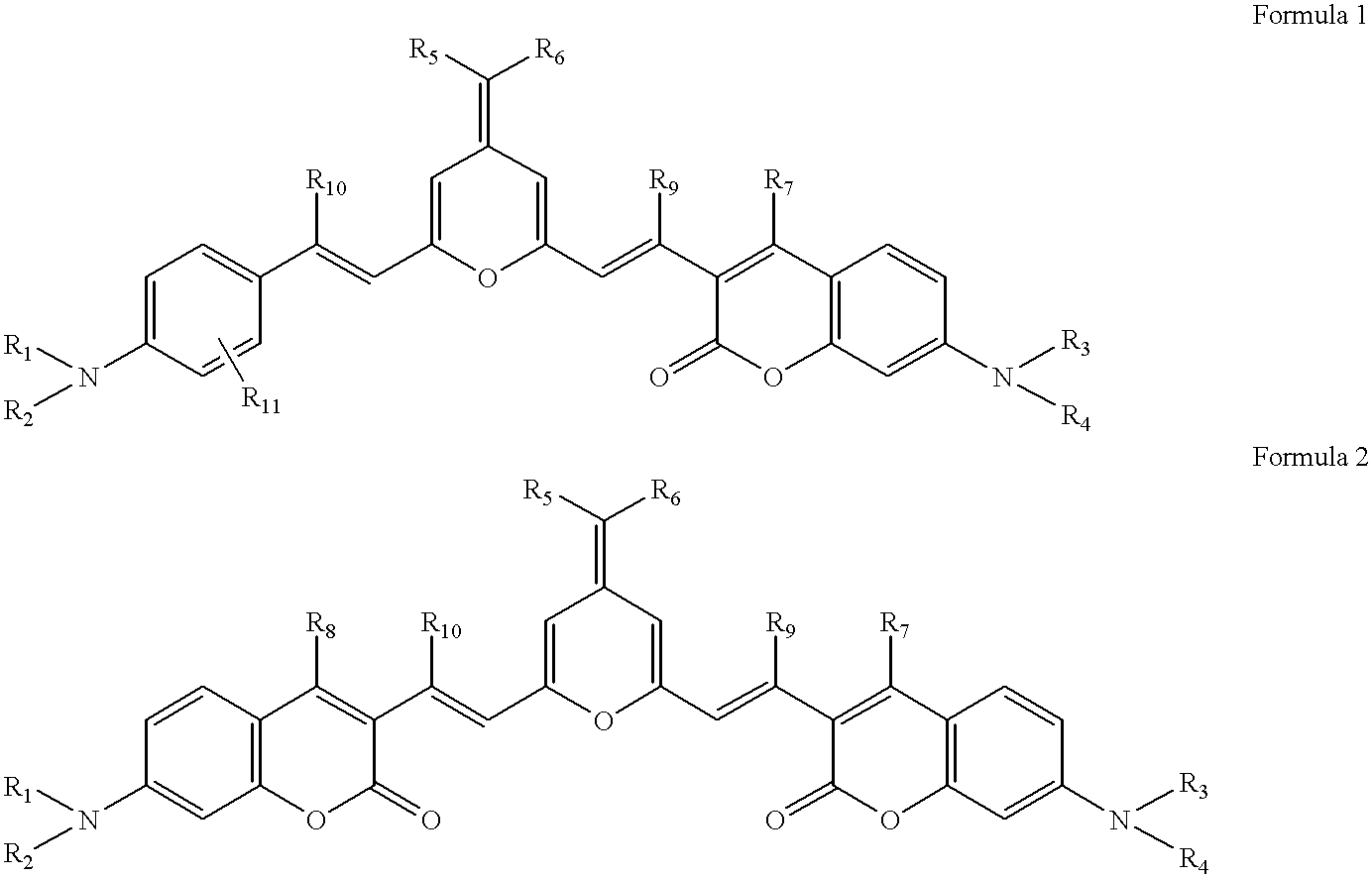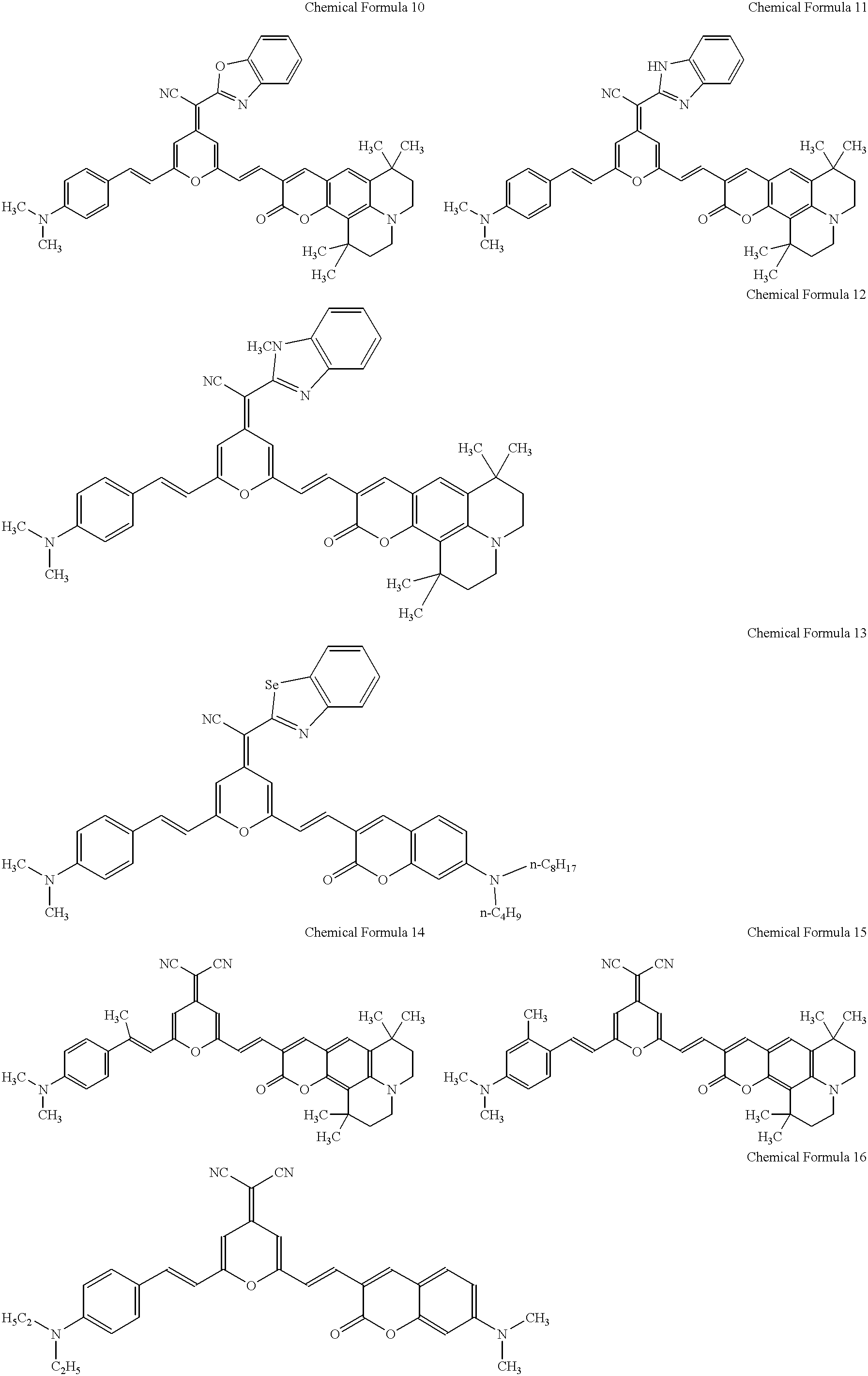Pyran derivatives
a derivative and pyran technology, applied in the field of pyran derivatives, can solve the problems of unignorable disadvantages and remarkable advantages of photosensitizers, large mass and weight, and inadequate tube for consumer equipment, and achieve the effect of high efficiency and use in photochemical polymerization
- Summary
- Abstract
- Description
- Claims
- Application Information
AI Technical Summary
Benefits of technology
Problems solved by technology
Method used
Image
Examples
example 2
Pyran Derivative
1.2 g of the compound represented by Chemical Formula 97 with a 4-dicyanomethylene-2-methyl-4H-pyran skeleton and 2.0 g of the compound represented by Chemical Formula 99 with a 3-formyl coumarin skeleton were dissolved in five milliliters of N,N-dimethylformamide. The solution was admixed with 0.5 ml piperidine, and the mixture was refluxed for two hours, then cooled to ambient temperature and filtered to collect the formed crystal. The crystal was recrystallized in N,N-dimethylformamide to obtain 0.8 g of a black crystal of the pyran derivative, represented by Chemical Formula 5. ##STR22##
Conventional measurement revealed that the pyran derivative had a melting point of 280-282.degree. C. and exhibited an absorption- and fluorescent-maxima at wavelengths of 503 nm and 656 nm, respectively, when measured in methylene chloride. Upon measurement of .sup.1 H-NMR in chloroform deuteride, the compound showed peaks at chemical shift .delta. (ppm, TMS) of 1.32 (6H, s), 1.5...
example 3
Pyran Derivative
0.8 g of the compound represented by Chemical Formula 100 with a 4-dicyanomethylene-2-methyl-4H-pyran skeleton and 1.1 g of the compound represented by Chemical Formula 99 with a 3-formyl coumarin skeleton were dissolved in five milliliters of N,N-dimethylformamide. The solution was admixed with 0.5 ml piperidine, and the mixture was refluxed for two hours, then cooled to ambient temperature and filtered to collect the formed crystal. The crystal was recrystallized in N,N-dimethylformamide to obtain 0.4 g of a red-black crystal of the pyran derivative, represented by Chemical Formula 17. ##STR23##
Conventional measurement revealed that the pyran derivative had a melting point of 195-197.degree. C. and exhibited an absorption- and fluorescent-maxima at wavelengths of 509 nm and 662 nm, respectively, when measured in methylene chloride. Upon measurement of .sup.1 H-NMR in chloroform deuteride, the compound showed peaks at chemical shift .delta. (ppm, TMS) of 0.96 (6H, t...
example 4
Pyran Derivative
0.8 g of the compound represented by Chemical Formula 101 with a 4-dicyanomethylene-2-methyl-4H-pyran skeleton and 1.2 g of the compound represented by Chemical Formula 98 with a 3-formyl coumarin skeleton were dissolved in seven milliliters of N,N-dimethylformamide. The solution was admixed with 0.7 ml piperidine, and the mixture was refluxed for two hours, then cooled to ambient temperature and filtered to collect the formed crystal. The crystal was recrystallized in N,N-dimethylformamide to obtain 1.0 g of a black crystal of the pyran derivative, represented by Chemical Formula 36. ##STR24##
Conventional measurement revealed that the pyran derivative had a melting point of 329-331.degree. C. and exhibited an absorption- and fluorescent-maxima at wavelengths of 500 nm and 618 nm, respectively, when measured in methylene chloride. Upon measurement of .sup.1 H-NMR in chloroform deuteride, the compound showed peaks at chemical shift .delta. (ppm, TMS) of 1.24 (12H, t),...
PUM
| Property | Measurement | Unit |
|---|---|---|
| wavelengths | aaaaa | aaaaa |
| wavelengths | aaaaa | aaaaa |
| wavelengths | aaaaa | aaaaa |
Abstract
Description
Claims
Application Information
 Login to View More
Login to View More - R&D
- Intellectual Property
- Life Sciences
- Materials
- Tech Scout
- Unparalleled Data Quality
- Higher Quality Content
- 60% Fewer Hallucinations
Browse by: Latest US Patents, China's latest patents, Technical Efficacy Thesaurus, Application Domain, Technology Topic, Popular Technical Reports.
© 2025 PatSnap. All rights reserved.Legal|Privacy policy|Modern Slavery Act Transparency Statement|Sitemap|About US| Contact US: help@patsnap.com



